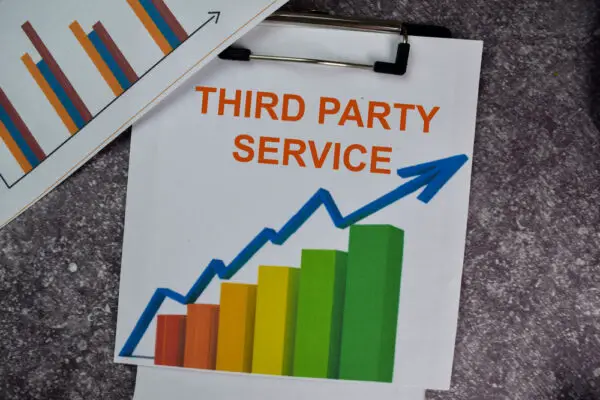Third-party risk assessment plays a pivotal role in ensuring the security and stability of organizations. In an increasingly interconnected business landscape, where organizations rely heavily on external vendors and partners, evaluating and mitigating risks associated with these relationships is paramount.
This article aims to provide an analytical and thorough analysis of third-party risk assessment, shedding light on its significance, process, and risk types.
To begin, we will define third-party risk management and delve into the concept of third-party risk assessment. We will explore the various risks organizations face when engaging with external parties, such as legal, operational, reputational, and compliance risks.
Understanding these risks is crucial for organizations to develop effective risk mitigation strategies.
Moreover, we will examine why conducting a risk assessment of third-party relationships is imperative.
By evaluating the potential risks external entities pose, organizations can proactively identify vulnerabilities and implement appropriate controls to minimize the impact on their operations.
Lastly, we will discuss how to conduct a supplier risk assessment on an ongoing basis, emphasizing the need for continuous monitoring and reassessment of third-party relationships.
Adopting a systematic approach, organizations can ensure that their risk management practices remain up-to-date and aligned with their evolving business environment.
This article aims to provide a comprehensive understanding of third-party risk assessment, equipping organizations with the knowledge and tools to manage and mitigate the risks associated with their external partnerships.

What is Third Party Risk Management?
Third Party Risk Management refers to the systematic process of identifying, evaluating, and mitigating potential risks associated with the involvement of external parties in an organization’s operations and decision-making processes.
It encompasses the management of risks arising from third-party relationships, as well as compliance with regulatory requirements.
A robust third-party risk management program should be based on a comprehensive framework.
This framework should include establishing a risk management strategy that aligns with the organization’s overall objectives and risk tolerance.
It should also involve developing and implementing policies, procedures, and controls to identify, assess, and monitor risks associated with third-party relationships.
Additionally, a vendor risk management program should be in place to evaluate the risks posed by specific vendors and ensure adequate risk mitigation measures are implemented.
Effective third-party risk management is crucial for organizations to safeguard their reputation, protect sensitive data, and maintain regulatory compliance.
What Is a Third-Party Risk Assessment?
Third-party cyber risk assessments are crucial in today’s interconnected business landscape.
These assessments evaluate the potential risks associated with engaging with third-party vendors, suppliers, or service providers who have access to sensitive data or systems.
Conducting thorough assessments, organizations can identify and mitigate potential vulnerabilities, ensuring the security and integrity of their own systems and data.
Why Are Third-Party Cyber Risk Assessments Important?
Conducting comprehensive cyber risk assessments for third-party vendors is crucial due to the potential vulnerabilities they may introduce into an organization’s network.
Third-party cyber risk assessments are important for several reasons:
1. Identifying vulnerabilities: By assessing third-party vendors’ cybersecurity practices, organizations can identify potential weaknesses that cyber attackers could exploit.
2. Meeting compliance requirements: Many industries have specific compliance requirements that organizations must adhere to.
Conducting third-party risk assessments helps ensure vendors meet these requirements, reducing non-compliance risk.
3. Determining risk level: Third-party risk assessments allow organizations to evaluate the level of risk associated with working with specific vendors.
This information helps organizations decide whether to engage with certain vendors or implement additional security measures.
4. Establishing risk tolerance: By understanding the risks posed by third-party vendors, organizations can establish risk tolerance levels and develop appropriate risk mitigation strategies.
Third-party cyber risk assessments are essential for organizations to mitigate potential vulnerabilities, comply with industry regulations, evaluate risk levels, and establish risk tolerance.
Types of Third-Party Risks
This discussion will focus on the various types of third-party risks, including:
– Cybersecurity risk refers to the potential for a third party to compromise the security of an organization’s systems and data, leading to unauthorized access or data breaches.
– Reputational risk: This involves the potential damage to an organization’s reputation if a third party engages in unethical or illegal practices.
– Operational risk: This encompasses the potential disruption to an organization’s operations if a third party fails to meet contractual obligations or experiences operational issues.
– Strategic risk: This refers to the potential impact on an organization’s strategic objectives and goals if a third party fails to align with the organization’s overall strategy.
Cybersecurity Risk
Cybersecurity risk is a critical aspect to consider in a third-party risk assessment, as it can significantly affect the security of an organization’s data and systems.
When engaging with third-party vendors, organizations must be aware of the potential cyber risks that may arise. Here are four important considerations:
1. Vendor vulnerability: Assess the security measures implemented by the third-party vendor to protect against cyber threats. This includes evaluating their data encryption methods, access controls, and incident response capabilities.
2. Data breach history: Investigate the vendor’s past experiences with data breaches and their response to such incidents. This information can provide insights into their ability to manage and mitigate cyber risks effectively.
3. Third-party risk assessment questionnaire: Utilize a comprehensive questionnaire to gather detailed information about the vendor’s cybersecurity practices. This can help identify potential vulnerabilities and weaknesses that may pose a risk to the organization.
4. Continuous monitoring: Implement a system for ongoing monitoring of the vendor’s cybersecurity posture. Regularly assess their adherence to security standards and evaluate any changes that may impact the risk landscape.
Organizations can better mitigate the security risks associated with engaging with third-party vendors by considering these factors and incorporating them into the third-party risk assessment metrics.

Reputational Risk
Reputational risk is a critical aspect of third-party risk assessment. When organizations engage in vendor relationships or form business partnerships, their reputation can be significantly impacted by the actions of their partners.
Reputational risk refers to the potential damage to an organization’s image, brand, or public perception due to the actions of its business partners.
Organizations need to conduct thorough assessments of their partners’ risk profiles to effectively manage this risk, including evaluating their track record, reputation, and compliance with relevant regulations.
By incorporating a 3-column and 3-row table, we can visually represent the different aspects contributing to reputational risk in third-party relationships.
This table can include factors such as the partner’s history of incidents, transparency and communication, and any past legal or ethical issues.
Such a comprehensive assessment can help organizations make informed decisions about their business relationships and minimize the potential impact of reputational risk.
Operational Risk
Operational risk, a crucial component of organizational risk management, encompasses the potential hazards and vulnerabilities that arise from internal processes, systems, and human error, impacting an organization’s ability to achieve its objectives.
Senior management must implement robust solutions throughout the organization’s operations to effectively manage operational risk. This includes establishing clear third-party onboarding processes that involve thorough assessments of vendors’ risk criteria upfront.
Organizations can mitigate operational risks more effectively by comprehensively evaluating potential risks associated with third-party relationships at the outset.
Furthermore, monitoring third-party activities is essential to identify and promptly address any emerging risks. This proactive approach enables organizations to maintain control over their operational processes, minimize vulnerabilities, and ensure the smooth attainment of their objectives.
Strategic Risk
Strategic risk, a critical element in organizational risk management, encompasses the potential uncertainties and threats that arise from an organization’s strategic decisions and external factors, influencing its ability to achieve long-term goals and objectives.
Organizations must identify and assess strategic risks to manage and mitigate them effectively. The third-party risk assessment process is crucial in evaluating the strategic risks associated with outsourcing activities.
This involves conducting security assessments to identify inherent risks and determining the organization’s risk posture.
Organizations can make informed decisions about engaging third parties by assessing the financial risk and potential impact on long-term goals. The residual risk, which remains after implementing risk mitigation measures, should also be considered.
Through a comprehensive analysis of strategic risks, organizations can better understand potential threats and uncertainties that may affect their long-term viability.

Why Do a Risk Assessment of Third-Party Relationships?
Conducting a risk assessment of third-party relationships is crucial to ensure the security and stability of the organization’s overall operations.
This assessment helps identify and mitigate potential risks associated with business partnerships.
To further understand the importance of such assessments, consider the following key points:
1. Risk Identification: A comprehensive risk assessment enables organizations to identify potential risks and vulnerabilities within their third-party relationships.
2. Security Posture: Assessing third-party risk helps organizations evaluate their security posture and identify areas that require improvement to protect sensitive information and assets.
3. Supply Chain Management: Conducting risk assessments of third-party relationships allows organizations to gain visibility into their supply chain and identify any potential risks that may impact the delivery of goods or services.
4. Vendor Assessment Questionnaires: Utilizing vendor assessment questionnaires provides a structured approach to evaluate third-party vendors and assess their ability to adhere to security and compliance requirements.
Through conducting a comprehensive risk assessment of third-party relationships, organizations can take proactive steps to address potential risks, safeguard their assets, and ensure the security and stability of their operations.
How to Conduct Supplier Risk Assessment on an Ongoing Basis
To maintain the security and stability of an organization, it is essential to evaluate and monitor the potential risks associated with suppliers continuously.
Conducting supplier risk assessments on an ongoing basis is crucial to ensure that third-party relationships do not pose any significant threats to the organization.
This continuous risk assessment allows for identifying and mitigating any potential vulnerabilities or weaknesses in the supplier’s operations or security protocols.
Regular assessments enable organizations to stay updated on the changing dynamics of supplier relationships and make informed decisions regarding managing these relationships.
Organizations can create a comprehensive framework for managing third-party relationships and ensuring the security of their systems and data by implementing thorough vendor risk assessment processes.
Regular third-party assessments also help maintain compliance with industry regulations and standards, enhancing the organization’s overall security posture.
Frequently Asked Questions
What are the key benefits of implementing third-party risk management?
Implementing third-party risk management has many benefits, including better control over risks, regulatory compliance, business continuity, improved decision-making, trust and transparency, and safeguarding reputation and customer trust.
What are the common challenges organizations face in conducting third-party risk assessments?
Common challenges in third-party risk assessments include limited resources, obtaining accurate information, and managing multiple relationships.
How can organizations identify and prioritize high-risk third-party relationships?
Organizations should conduct thorough due diligence to identify and prioritize high-risk third-party relationships, including assessing financial stability, reputation, compliance, and security.
They can use risk-scoring models and continuous monitoring to assess ongoing risks.
What are some best practices for mitigating and managing third-party risks?
To mitigate and manage third-party risks, follow these best practices: do background checks on potential partners, use strong contracts, monitor and assess third parties regularly, maintain clear communication, and have a solid risk management framework.
How can organizations ensure ongoing monitoring and reassessment of third-party risks over time?
To manage third-party risks effectively, organizations should regularly audit vendors, monitor their performance, and reassess risks based on changes in the business environment and vendor relationships.

Conclusion
Conducting a third-party risk assessment is essential for effective risk management. It helps organizations identify and evaluate potential risks associated with external parties, reducing negative outcomes.
It’s important to regularly assess risks and monitor third-party relationships to avoid financial and reputational harm.
Organizations can protect themselves and make informed decisions using a risk assessment framework.

Chris Ekai is a Risk Management expert with over 10 years of experience in the field. He has a Master’s(MSc) degree in Risk Management from University of Portsmouth and is a CPA and Finance professional. He currently works as a Content Manager at Risk Publishing, writing about Enterprise Risk Management, Business Continuity Management and Project Management.

